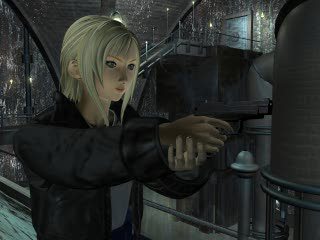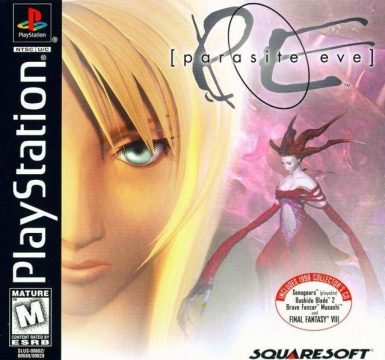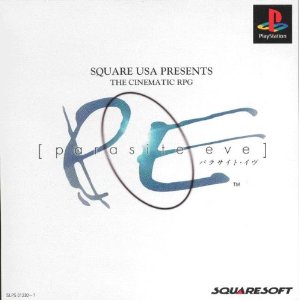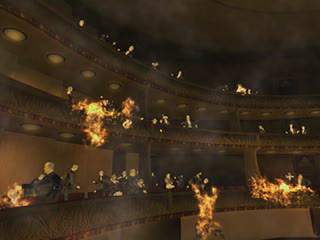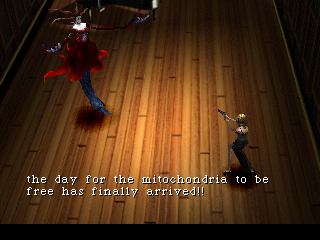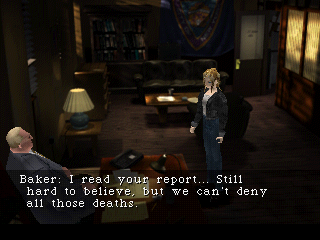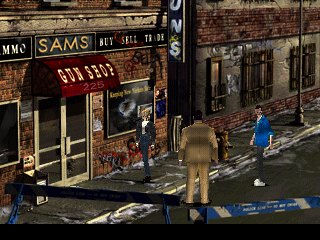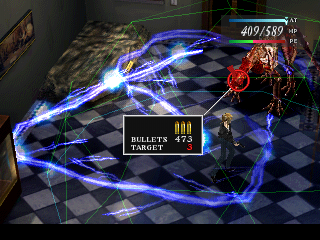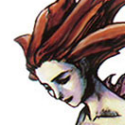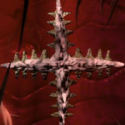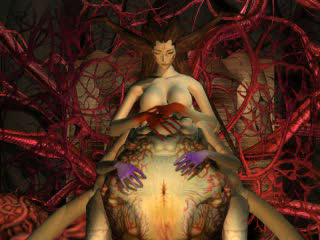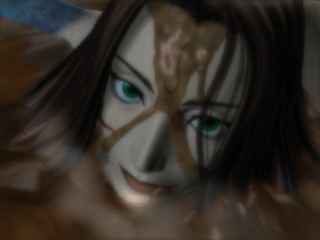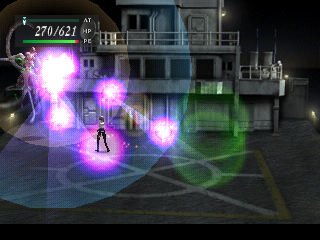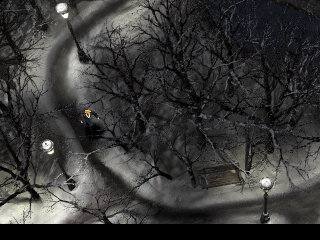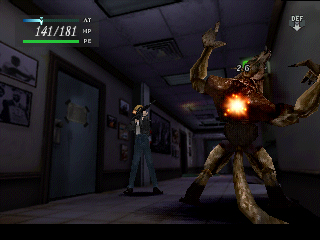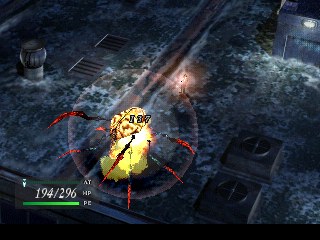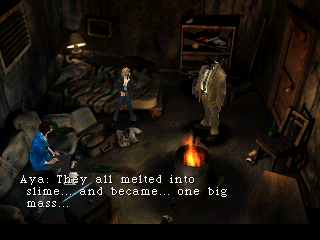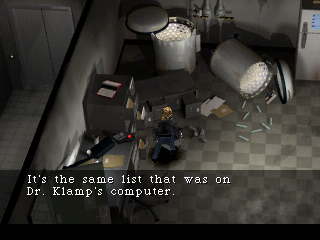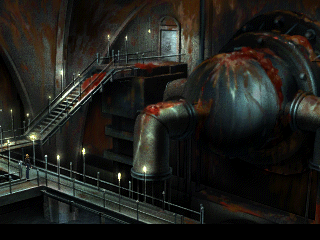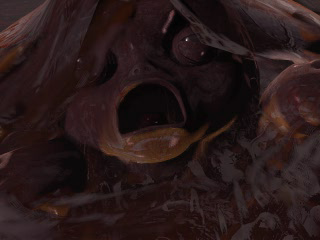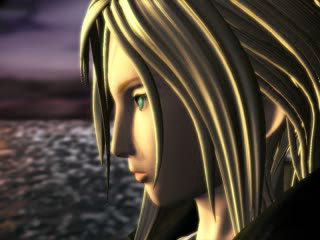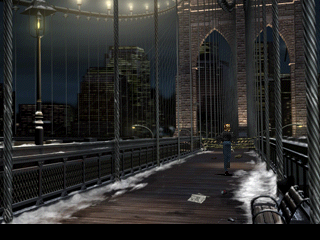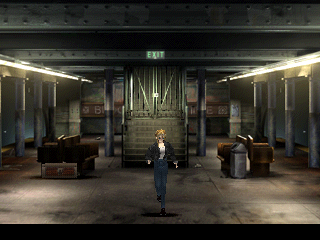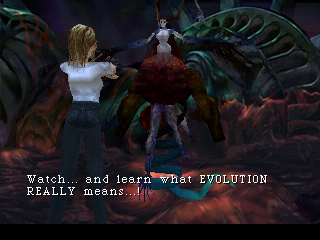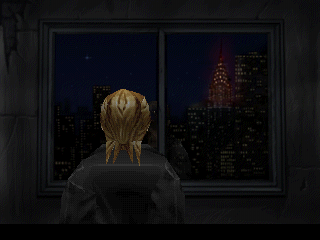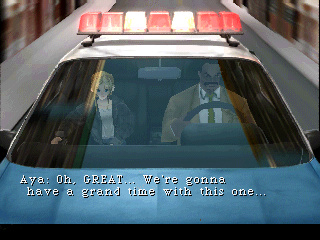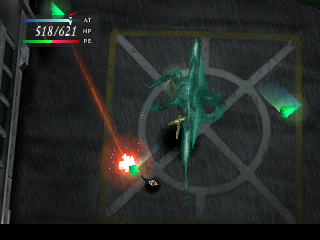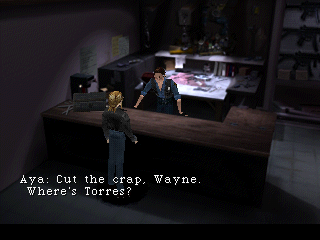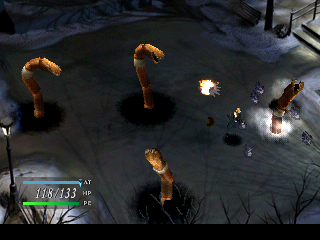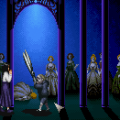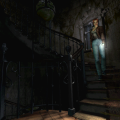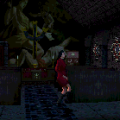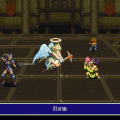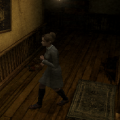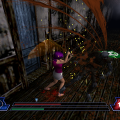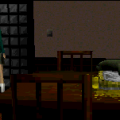1998: a Japanese video game studio called SquareSoft (known primarily for its role-playing games) enjoys its well-earned spot in the limelight. Having just capped off a string of trans-Pacific hits (1994’s Final Fantasy VI, 1995’s Chrono Trigger, 1996’s Super Mario RPG,) with a once-a-generation phenomenon (1997’s Final Fantasy VII), boasting a golden reputation for being on the cutting edge of the industry, and equipped with a robust production budget, the company (guided by Final Fantasy creator and patriarch Hironobu Sakaguchi) figures it can afford to be ambitious. By now SquareSoft had already begun branching off into different types of games (text-based adventure Radical Dreamers, real-time strategy Front Mission Alternative, strategy RPG Final Fantasy Tactics, horizontal shoot-em-up Einhänder), and has lately been attempting to push the envelope in terms of what its bread-and-butter genre – the console RPG – is capable of doing.
According to interviews with SquareSoft staffers (referenced extensively across cyberspace, but with apparently without magazine scans/transcriptions), Sakaguchi’s original plan for Final Fantasy VII was a detective story taking place in modern-day New York City. Sakaguchi obviously had to make a few concessions, and so the first few hours of Final Fantasy VII are set in a squalid metropolitan nightmare from which the player is then ejected to run, ride, and fly around a more familiar RPG world map for the rest of the game. Eventually, Sakaguchi had his way and got his NYC detective game, though not in the form of a Final Fantasy title.
Parasite Eve. Marketed in the States as SquareSoft’s first post-Final Fantasy VII big-budget title, it was the company’s first game to receive an “M” rating from the ESRB, and possibly the first video game to refer to itself as a “cinematic RPG.” This an amalgamation of amalgamations. It’s an attempt to splice the console RPG with a survival horror game (as popularized by Resident Evil), and also a new phase in SquareSoft’s scheme to make games that behaved more like film – or at least into something commanding more respect than electronic toys.
Filling the RPG part of the equation – the hit points, battle mechanics, and storyline/scenario stuff – was director and lead designer Takashi Tokita, who had previously directed Final Fantasy IV and Chrono Trigger. (Note: Tokita’s name only appears in the credits of Parasite Eve 2 as a “special adviser” and not at all in 3rd Birthday.) Also on board were Yoshihiko Maekawa (Super Mario RPG director) as battle designer, Shinichiro Okaniwa (Secret of Mana character designer, Chrono Trigger field graphic designer) as battle effects director, and Yoko Shimomura (Street Fighter II‘s soundtrack) brings a killer soundtrack that’s a little bit operatic and a little bit 1990s electronica.
For the storyline, Tokita adapted the plot of a 1996 Japanese horror novel called Parasite Eve, which later was made into a movie. Despite going by the same title, Parasite Eve (the game) is not a conversion of the book or the movie. Rather, it’s presented as a distant sequel. And like any good sequel, Parasite Eve (the game) raises the stakes, amps up the danger, and piles the bodies much higher.
But for the “cinematic” element of their new RPG, SquareSoft looked abroad. Browsing the staff credits, you’ll notice an unusual abundance of Western names, and they’re not limited to the localization team. If absolutely nothing else, Parasite Eve lives up to its cinematic RPG boast in that it contains a lot of CG cutscenes, and they tend to be on the long side (by 1998 PlayStation standards). Most of these were developed in the United States by folks with Hollywood experience. If you were to punch the names credited as “CG supervisors” into the Internet Movie Database, you would see some familiar movie titles on some of their resumes: Cliffhanger, Die Hard: With a Vengeance, Super Mario Brothers (the movie), Apollo 13, (uh oh) 2001’s Final Fantasy: the Spirits Within.
You can see SquareSoft’s investment paying itself off within the first ten minutes of the game. First of all, the CGI montage during the demo demonstrates a very noticable improvement over Final Fantasy VII‘s cinematics. And secondly, the first proper in-game cinematic gives us the most memorable opera scene in a SquareSoft game. Yes, yes, sure: Final Fantasy VI‘s opera house scene was a milestone in video games’ evolution into a unique form of interactive art with its own unique yeah yeah yeah. Parasite Eve‘s opera scene features a state of the art (again, by 1998 standards) CGI sequence in which half the audience of Carnegie Hall’s Christmas Eve performance bursts into flames and dies horribly. Merry Parasite, fuckers! The audience is definitely listening.
The Cast
Aya Brea
A 25-year-old NYPD detective present at ground zero of Eve crisis’s prologue. Not only does she demonstrate an immunity to Eve’s powers, but her contact with the entity seems to have granted her similar abilities of her own. As the only person who can even approach Eve without melting or bursting into flames, Aya takes responsibility for putting down Eve and her terrors.
Daniel Dollis
Maya’s partner on the force is one-half Barrett, one-half Danny Glover: he’s short tempered, quick to throw a punch, steadfastly devoted to his family, and definitely too old for this shit. If this were a typical SquareSoft RPG, Daniel would be party member #2. But as this is a special SquareSoft cinematic RPG, Daniel is merely Aya’s wacky co-star.
Kunihiko Maeda
A Japanese biologist who hurries to the States when he hears reports of the Carnegie Hall catastrophe. His familiarity with the details of Eve’s first awakening in Japan (re: the Parasite Eve novel) and knowledge of cellular biology make him an invaluable addition to the crew. If Parasite Eve were a typical SquareSoft RPG, Maeda would be party member #3, but as things are, he is wacky co-star #2 and a handy exposition device.
Eve
The body belongs to an opera singer named Melissa Pearce, but the cells – and brain – have been hijacked by a collective mitochondrial consciousness called Eve. Her cells are able to communicate with those of other organisms, essentially making any living thing within range putty in her claws. She turns animals into monsters by warping their cellular physiology, and deals with humans by either setting them on fire or melting them into a formless, malleable biomass. Her goal is to propagate her DNA and create the “Ultimate Being,” an organism that can control its own evolution and supplant terrestrial life with its awful progeny.
From Wikipedia:
In cell biology, a mitochondrion (plural mitochondria) is a membrane-enclosed organelle found in most eukaryotic cells. These organelles range from 0.5 to 1.0 micrometer in diameter. Mitochondria are sometimes described as “cellular power plants” because they generate most of the cell’s supply of adenosine triphosphate (ATP), used as a source of chemical energy. In addition to supplying cellular energy, mitochondria are involved in other tasks such as signaling, cellular differentiation, cell death, as well as the control of the cell cycle and cell growth.
Several characteristics make mitochondria unique. The number of mitochondria in a cell varies widely by organism and tissue type. Many cells have only a single mitochondrion, whereas others can contain several thousand mitochondria. The organelle is composed of compartments that carry out specialized functions. These compartments or regions include the outer membrane, the intermembrane space, the inner membrane, and the cristae and matrix. Mitochondrial proteins vary depending on the tissue and the species. In humans, 615 distinct types of proteins have been identified from cardiac mitochondria, whereas in Murinae (rats), 940 proteins encoded by distinct genes have been reported. The mitochondrial proteome is thought to be dynamically regulated. Although most of a cell’s DNA is contained in the cell nucleus, the mitochondrion has its own independent genome. Further, its DNA shows substantial similarity to bacterial genomes.
Parasite Eve‘s premise claims that throughout the history of Earth, the mitochondria have been pretending to be team players, biding their time until (1) they were sufficiently evolved to hijack and conquer all terrestrial life (2) they had helped terrestrial life evolve into something worth conquering. Like most sensible sci-fi, Parasite Eve divulges just enough scientific fact to lend credence to its premise, and omits all the details which make it absolutely impossible and absurd.
Knowing Parasite Eve had been masterminded by the directors of Final Fantasy IV and Super Mario RPG (two of the most fun console RPGs of all time), the savvy gamer might expect a battle system worth the price of admission. The game does not disappoint.
Like most RPG protagonists, Aya collects experience points and gains levels by winning battles and gains levels. Upon leveling up, Aya receives a stat boost and occasionally learns new Parasite Abilities (more on these in a moment). She also earns bundles of “bonus points” that can be used to increase the speed of her ATB gauge, raise her item capacity, or modify the stats of her weapons and armor.
Parasite Eve’s battles are a little bit SquareSoft RPG and a little bit survival horror. Aya wanders the field screen freely until coming across a battle trigger point. These are apparently random, but usually occur at certain places on certain maps, and the activation probability varies on a case-by-case basis. (For instance, the encounters in Central Park might not be triggered at all, while ones in the Natural History Museum and Warehouse are mandatory.) Aya can still move about freely during a fight, but cannot leave the screen until the it ends.
When the ATB gauge fills, the player can either input a battle command (shoot, item, escape, etc.) or keep moving around (indefinitely) to find a more advantageous position or dodge attacks. Once a target is chosen and Aya begins squeezing the trigger, she stands still until her designated rounds have been fired, effectively making her a sitting duck.
Aya possesses an MP well in the form of a “Parasite Energy” gauge that replenishes itself automatically during battles (but at a slower and slower rate as time passes). Most of Aya’s Parasite Abilities are heals and buffs; the few offensive powers she has are exceedingly strong, but come with steep costs (usually the whole PE gauge and an additional “stagger” period following activation). Parasite Eve wants you to effect most of the mutant slaughter via firearms, as you would in most survival horror games.
Parasite Eve hands Aya a variety of weapons to choose from (pistols, rifles, machine guns, shotguns, grenade launchers, etc.), each with differing properties (range, clip size, rate of fire, etc.). Unlike most survival horror games, there are as many different models of pistol as swords in your average console RPG, meaning that the pistol you just found will likely be stronger than the rifle you came across two chapters back. What’s more, weapons and armor have common RPG battle system properties, such as first strike, ice elemental, add poison, auto potion, doublecast, etc. The game also has an equipment mod system in which weapons and armor can be broken down and their modifiers transferred to other items, similar to the mechanics seen later in Vagrant Story and Final Fantasy XIII.
Unusually, Parasite Eve is an RPG in which there are no merchants and there is no money to collect. Aya cannot purchase ammo or items, and must rely on treasure chests, locker contents, and item drops to stay armed and healthy. Watching your ammo and recovery item stocks dwindle down towards nothing causes just as much anxiety in Parasite Eve as in a Resident Evil title. (Fortunately, Aya’s melee weapons usually have a “steal item” property attached.)
For advanced players and compulsive completionists, Parasite Eve offers a kind of New Game+ in which Aya starts out equipped with the “engraved” gear she had at the game’s end. (After a couple of cycles and some judicious modding, these can get pretty nasty.) It also unlocks a special optional dungeon on the Manhattan map: the insidious Chrysler Building. Seventy-seven floors of randomly-generated maps, bosses at regular intervals, and monsters of escalating power. At the top is an optional (or perhaps the true) endboss, and an alternate ending as a reward for players with enough dedication to defeat it. (Back before YouTube, this sort of thing was a much bigger deal than it would be today.)
Whatever was in the tap water at the SquareSoft building during Final Fantasy VII‘s development doesn’t seem to have been completely flushed out before Parasite Eve was underway. Perhaps the fact could be attributed to its genesis as a discarded Final Fantasy VII scenario, but Parasite Eve exhibits more common DNA with SquareSoft’s biggest hit than any of the Final Fantasy VII sequels, prequels, or spin-offs. Arguments:
1.) Gloomy concrete jungles. Final Fantasy VII begins in Midgar (its most memorable location by a tremendous margin) and then wanders elsewhere. Parasite Eve never leaves the city, and SquareSoft’s Manhattan feels very similar to Midgar.
2.) Final Fantasy VII could, at times, evoke a very palpable menace, and much of this springs from its environments. Parasite Eve follows suit to an extent that other Final Fantasy games do not. Its Central Park exudes the same fearful desolation as the Niebel mountains; the sewer reservoir under Chinatown has the scale and semblance of a Mako reactor; the empty hospital is pretty much the Shinra Mansion with a white paint job.
3.) Alien/mutant body horror. Eve’s metamorphoses bear more than a small semblance to Jenova’s morphology – which shouldn’t come as a surprise, since both creatures were designed by a young Tetsuya Nomura.
4.) Demonic mothers and the apocalyptic ascensions of their godlike sons.
5.) Environmental messages. In Parasite Eve‘s case, the cautionary green talk is crammed in at the very end, but it’s nevertheless there.
6.) Identity crises. Cloud fears and doesn’t understand himself. Aya doesn’t understand her powers and fears what she might become.
7.) A sense of timeliness. Both games are almost unnervingly contemporary in a way that SquareSoft games beyond the company’s magical PlayStation period don’t really duplicate.
8.) Ambiguous endings.
9.) Like Final Fantasy VII, Parasite Eve‘s English translation is a bit wonky. It’s not nearly as awkward, but the flavor is quite similar. (Some of us are actually rather fond of it.)
10.) Forget Lightning. Aya is the original female Cloud. Arguments: she’s a loner with a smart mouth, but has a heart of gold beneath her prickly and aloof exterior. She experiences inexplicable flashbacks and receives extrasensory advice from an apparently halluncinatory source. She’s powered by the cells of a foreign entity and locked in a fierce, vaguely homoerotic rivalry with a fathomlessly strong opponent with an advanced mastery of their common power. And while she doesn’t often wear a dress, she nevertheless looks good in one.
Parasite Eve serves as a stellar example of the strange and cool transitional console RPG of the PlayStation era: a relic from that exciting period when developers wanted to make their games more realistic and cinematic, but lacked the hardware to engineer the voiced, engine-rendered cutscenes that became the standard only a few years later. These games’ unique narrative and directorial toolkits were jury-rigged out of necessity, and then widely discarded once hardware improvements made them unnecessary.
What might be most striking about Parasite Eve compared to later “cinematic” games is its silence. This was noticed early on: upon the game’s release, many critics in complained about its lack of voiced dialogue. Why not? By this time it was certainly possible. (Look at the dialogue-packed and fully voiced Metal Gear Solid, for instance, also released in 1998. SquareSoft’s own Brave Fencer Musashi, released earlier in the year, had been voiced as well.)
The developers certainly could have chosen to implement a voiceover if they wished, but opted not to. It would be interesting to hear their rationale. Maybe they felt they’d gotten so good at conveying articulate but mute narratives during the SNES period that they didn’t want to risk a misstep on an already ambitious project by wandering into totally unfamiliar territory.
Video games were and are allowed to do things differently than film, and it’s great fun to watch SquareSoft taking advantage of the medium’s idiosyncracies. The mute-but-articulate dialogue gives these PS1-era games a unique narrative rhythm, existing in some phantom zone between a graphic novel and a CG film. Interesting stuff happens, like animated, dialogue-heavy scenes in which the only audible sounds are shoe soles on floor tiles and the klak klak klak of a computer keyboard. During the really flashy and dramatic scenes – the explosions, the mutations, the revelations, the transitions, etc. – are mostly conveyed through CGI cutscenes, which mean there is no dialogue (no text) during most of the critical “oh shit” scenes. (In a film, these would be rife with screams, curses, and one-liners.) It makes Parasite Eve cinematic in a sort of way that likely wouldn’t work in an actual film, but works beautifully in a game.
(One consideration: axing the voiceover eliminates any possibility of audiovisual dissonance between the somewhat crude-looking and mouthless polygonal humanoids and the length and tone of their spoken conversations. If you recall, most of the heavier and lengthier conversations in Metal Gear Solid occur between 2D rendered faces in the comm link screen and not between people standing right next to each other in the polygonal game field.)
In many ways, Parasite Eve might also be assessed as a preview of Square Enix and the (popularly perceived) malaise of the Japanese video game industry. It is extremely linear. The player spends about as much game time watching characters gab at each other as exploring Manhattan and fighting battles. The environments are beautifully rendered, but have all the functionality of cardboard stage sets. The story is actually pretty silly, but given an extremely serious and sophisticated presentation. (The evil mitochondria thing is hard to swallow, sure – but are we honestly expected to accept that all Manhattan could be evacuated in a single day?!) But for some reason, Parasite Eve isn’t nearly as much of a drag to play as, say, Final Fantasy XIII.
More than the flashy cinematics, backing up Parasite Eve‘s “cinematic” claim is its conciseness. Films tend not to waste time. A movie has a lot of ground to cover and it usually can’t count on its audiences to keep paying attention beyond 120-180 minutes. Back in 1998, many reviewers criticized Parasite Eve‘s length. Hardly the sort of sprawling epic one would expect from SquareSoft, it’s an RPG that can be completed in about fifteen hours. But this rather works in Parasite Eve‘s favor rather than to its disadvantage.
Parasite Eve does not waste time. There is almost no filler whatsoever, no stretches where Aya meanders around looking for something to do or waiting for something to happen. No cute little subplots about clashes with provincial minor villains, stolen item satchels, or we can’t open the gate to the next area without the four magical crystals, which are scattered in previously out-of-reach areas in places we’ve already passed through. From beginning to end, the whole game is Aya vs. Eve. (Contrast with Final Fantasy VII, in which Cloud vs. Sephiroth is mostly in the background while the cast runs around the world doing and talking about other things.) Though there are lulls in the action and long periods where characters stand around the police station and ruminate leads, their chitchat almost always pertains to the subject at hand: again, Aya vs. Eve.
(Reading interviews about the SquareSoft/Square Enix RPG development process, you get the impression that a whole bunch of people sit around and work separately on a whole bunch of tenuously-related subplots, and then just stitch the whole mess together at the end. Even the best SquareSoft games often have a disjointed, patchwork composition. Parasite Eve‘s focus is almost laser-like.) By the time you begin to notice that the beautiful environments have fewer things to examine and poke at than you’d like, and start feeling that the battles are wearing towards repetitive – well, it’s no longer an issue, because the game is just about over. Climax and thrilling endboss fights incoming!
Parasite Eve is a pretty decent game, though not without issues. Even during the company’s prime, its games were imperfect – but also daring and consistently interesting. Upon scrutiny, there’s a lot of nits that can be picked. New York City feels like such a small place; most locations are only made up of a handful of maps, and there’s not much to do in them. Most of the detective work is restricted to finding an open journal on a desk or searching a basement for missing fuses. Despite the sweetness of the game’s shortness, it really could have benefited from just a couple more optional maps and a few more boss fights. When it ends, you’ll be wishing it were longer. Then again, this is usually the mark of a good game.
These days it can be easy to forget how Square was able to grow to such a monstrous size. Parasite Eve is an excellent reminder as to why its success once seemed so well-deserved. Of course, Square saw fit to follow up the game with two sequels, neither of which were anywhere to the quality of this one.
